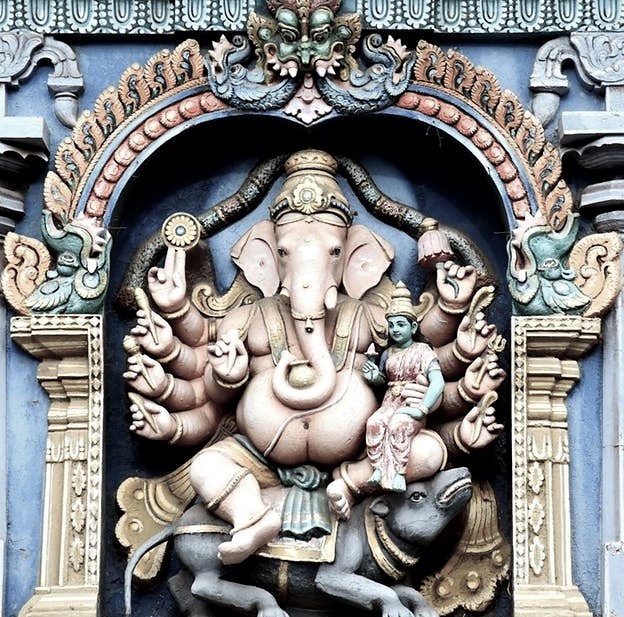- Special FeaturesFoundation YearSthala TreeTheerthamRathamArchitectureOther Speciality
- Sthala Puran
Designated by UNESCO as a World Heritage Site, the Elephanta Caves are a collection of cave temples predominantly dedicated to the Hindu god Shiva. They are on Elephanta Island, or Gharapuri (literally "the city of caves"), in Mumbai Harbour, 10 kilometres (6.2 mi) east of Mumbai in the Indian state of Mahārāshtra. The island, about 2 kilometres (1.2 mi) west of the Jawaharlal Nehru Port, consists of five Hindu caves, a few Buddhist stupa mounds that date back to the 2nd century BCE, and two Buddhist caves with water tanks.
The Elephanta Caves contain rock cut stone sculptures, mostly in high relief, that show syncretism of Hindu and Buddhist ideas and iconography. The caves are hewn from solid basalt rock. Except for a few exceptions, much of the artwork is defaced and damaged. The main temple's orientation as well as the relative location of other temples are placed in a mandala pattern. The carvings narrate Hindu mythologies, with the large monolithic 20 feet (6.1 m) Trimurti Sadashiva (three-faced Shiva), Nataraja (Lord of dance) and Yogishvara (Lord of Yoga) being the most celebrated.
These date to between the 5th and 9th centuries, and scholars attribute them to various Hindu dynasties. They are most commonly placed between the 5th and 7th centuries. Many scholars consider them to have been completed by about 550 CE.
They were named Elefante – which morphed to Elephanta – by the colonial Portuguese who found elephant statues on the caves. They established a base on the island. The main cave (Cave 1, or the Great Cave) was a Hindu place of worship until the Portuguese arrived, whereupon the island ceased to be an active place of worship. The earliest attempts to prevent further damage to the caves were started by British India officials in 1909. The monuments were restored in the 1970s. In 1987, the restored Elephanta Caves were designated a UNESCO World Heritage Site. It is currently maintained by the Archaeological Survey of India (ASI).
- Architecture
On the wall to the east of the Trimurti is a damaged four-armed Ardhanarishvara carving. This image, which is 5.11 m (16.8 ft) in height. It represents the ancient Hindu concept of essential interdependence of the feminine and the masculine aspects in the universe, for its creation, its sustenance and its destruction. It is represented as half woman shown as half of Parvati in this Elephanta panel on the right side, with breast, waist, feminine hair and items such as a mirror in the upper hand. The second half-man side is Shiva with male characteristics and items iconographically his symbol. In Shaivism, the concept pictorially symbolizes the transcendence of all duality including gender, with the spiritual lacking any distinctions, where energy and power (Shakti, Parvati) is unified and is inseparable with the soul and awareness (Brahman, Shiva).
In the panel, the relief shows a headdress (double-folded) with two pleats draped towards the female head (Parvati) and the right side (Shiva) depicting curled hair and a crescent. The female figure has all the ornamentation (broad armlets and long bracelets, a large ring in the ear, jewelled rings on the fingers) but the right male figure has drooping hair, armlets and wristlets. One of his hands rests on Nandi bull's left horn, Shiva's mount, which is fairly well preserved. The pair of hands at the back is also bejewelled; the right hand of the male side holds a serpent, while the left hand of the female side holds a mirror. The front left hand is broken, while a large part of the lower half of the panel was damaged at some point. Around the Ardhanarishwara are three layers of symbolic characters. The lowest or at the same level as the viewer are human figures oriented reverentially towards the androgyne image. Above them are gods and goddesses such as Brahma, Vishnu, Indra and others who are seated on their vahanas. Above them are flying apsaras approaching the fused divinity with garlands, music, and celebratory offerings
- Alankar of Deity
- Prayers and BenefitsSpecial Vratas and PrayersOfferings to DeityStotras and Mantras
- Festivals
- Sodasha Upcharas
- Prasadhas
- Social ActivitiesAnnadhanMarriageEar BoringHead ShaveDanaasEducation FacilitiesSocial DrivesOther Activities
- Arjita Seva
- Tags

